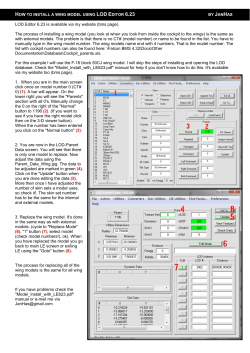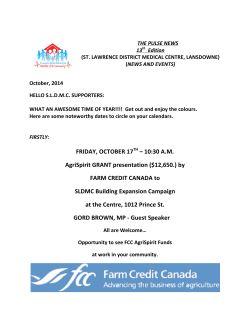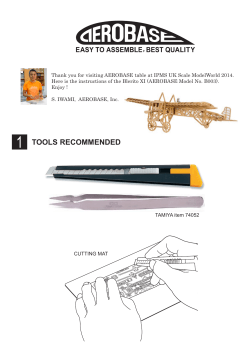
Lazer directions in PDF
LAZER II Assembly Instructions LAZER II ASSEMBLY INSTRUCTIONS What you’ll need: Optional: Other Components: Hobby knife Low Temp Hot-melt glue gun and glue sticks 2712-12 Motor with aluminum firewall mount 2-part 5 minute epoxy Lazer foam pieces: 3mm Prop saver, and or HOT GLUE Gun 1. Main Wing 8X6 Slow Fly or Direct drive Prop multitemp hotglue 2. Right half Cockpit Wooden Motor Mount Pliers 3. Left half Cockpit 10 amp ESC - Brushless Speed Controller (4) #4 wood screws 4. Right Lower Reinforcement Receiver (1) 1.5mm hex key wrench 5. Left Lower Reinforcement Mixer- *if your radio does not do mixing 6. Right Rudder Right Servo 7. Left Rudder Left Servo 8. Right Elevon Rudder Hinge (BLENDERM TAPE) 9. Left Elevon Control Rods (2) Control Horns (2) EZ-JUSTERS Control Rod retainers (2) Carbon Fiber Reinforcement Rod 800 Mah Lithium-Polymer (Lipo) Battery START ASSEMBLY 1. Hint: Hot-melt glue works well for gluing the foam pieces together. It allows you to reposition the piece but also dries fast. You can also reheat exposed glue for smoothing or removing excess. Be careful not to touch the hot tip of the glue gun to the foam as it will melt the foam. 2. Prepare the foam pieces. Using sandpaper, create a radius by gently sanding away some of the foam material on the leading edges of the wings and each tail piece. This will help to decrease wind resistance 3. Add Carbon Fiber- On the new Version there is a slot cut across the wing that the piece of 1mm X 6mm that is 19 1/2" long flat carbon fiber gets glued into the slot , on the older version use a 3mm round carbon rod and glue across wing about 1/2 "in back of the servo openings on the bottom side of each wing, for extra strength add 2mm or 3mm carbon fiber rods along each side of the leading edge of the wing should end at the wing tips. This will provide added strength for any impact to the wing. Page 1 LAZER II Assembly Instructions 4. Attach Vertical Stabilizers (Rudders) slide the rudder into the slot in the back of the wing until it stops. Be sure that the servo notch in the rudder is lined up with the servo hole in the wing. It is VERY important to be sure that the rudder is perpendicular to the wing and the trailing edge of the wing is parallel with the centerline of the plane. (This should look like a perfect X. Once you have verified that the rudder is in the correct position, then glue all surfaces where the wing and the rudder meet. Repeat this procedure for the remaining rudder. 5. Optional. Add additional reinforcement pieces. There are certain places where it can help to have additional support. This is especially true for the less experienced pilots who tend to inflict more damage while in a learning mode. The extra foam or carbon fiber material can be used in fuselage and around battery compartment. 6. Make the fuselage by joining the Right and Left halves of the Cockpit, making sure the pieces are aligned front and back and top/bottom. Glue with epoxy or hot glue and lay on a flat surface till set. 7. Now attach Cockpit to Wing. With the Cockpit turned at a 10 degree angle to the wing, slide the cockpit into place. Ensure that the tabs on the cockpit drop into the holes in the wing. It is VERY important to be sure that the cockpit is perpendicular to the wing. Glue the bottom wing side first by pulling the cockpit away from the wing and applying glue under it and to the edge of the cockpit that will contact the bottom of the wing. When this is dry do the same to the edge of the cockpit that contacts the top of the wing. Place a bead of glue around the entire topside of the cockpit-wing joint. 8. Hint: When gluing the cockpit to the bottom of the wing, be sure that no glue squeezes out of the joint. Any glue that does will interfere with the attaching of the cockpit reinforcement pieces Page 2 LAZER II Assembly Instructions 9. Attach lower Battery Compartment Reinforcements to the bottom fuselage. Glue the right and left Battery Reinforcement pieces onto the right and left sides of the lower fuselage. Be sure that the battery slots line up. Place a bead of glue around the entire bottom side of the cockpit-wing joint. 10. Attach Wooden Motor Mount (B). Center the motor mount on the aft end of the fuselage where the fuselage and the wing intersect. The bottom of the mount should be flush with the bottom of the wing. It should be perpendicular to the wing or slight down thrust. Once the positioning is determined glue the mount to the plane. After the glue has dried place layers of hot-melt glue where the mount is not contacting any foam surface. This build-up of glue will help support the motor. (See image 7&8) On the underside of the wing near the motor mount, smear a thin layer of glue to reinforce the foam and prevent it from cracking. 11. Prepare the Elevons. First, assemble EZ Justers and insert in the top hole of the Control Horn. Tighten the retaining nut and check that the EZ juster can move. Put a drop of CA or thread lock on the threads so the nut does not unscrew. 12. Place the control horn over the slot in the elevon so that the horn angles toward the front of the plane and the top Page 3 LAZER II Assembly Instructions 12. Place the control horn over the slot in the elevon so that the horn angles toward the front of the plane and the top hole is directly over the front edge of the elevon, then glue in place. Be sure that the forward-most part of the horn is no farther forward than the leading edge of the elevon. Using sandpaper or knife cut a 45 degree bevel on the leading edge of each elevon by sanding or cutting away the bottom leading edge of the elevator. This allows the elevator to move in the down direction; ensure that this movement is unhindered. You may need to trim part of the elevon away so that it does not contact the rudder at any point in its travel. 13. Attach the elevons. Cut a piece of Blenderm tape 1/4” shorter than the length of the elevon. Place the piece tape half on the trailing edge of the wing where each elevon will be placed. Then slide the elevon up against the training edge of the wing (holding it down at a 30 degree angle) and press the tape on starting at the center and working it to the outside. (It’s not a bad idea to tape the underside of the wing tucking it in the 45 degree grove. 14. Mount Servos by pressing the servos into the knock-outs in the top of the wing. You may have to make an impression and then trim away foam to get them to fit properly. The servo should be oriented so that the gear/servo arm should point away from the center of the fuselage. Once the servos are positioned squarely glue them in place on the underside of the wing. HINT: you can put clear tape on the servo to make it easy to remove the glue from the servo later. Install the servo arms so that they are pointing straight up at 90 degrees– or as close to vertical as possible. Be sure to secure with the screw. 15. Mount the motor. Secure the aluminum motor mount to the wooden motor mount using three small wood screws. Once secured mount the motor and tighten the set screw on the aluminum mount. Push the connectors onto the motor leads of the speed controller. To change the rotation of the motor reverse any 2 Motor leads if necessary. Be sure to use shrink tubing to insulate the motor connections from shorting together. 16. Connect other Electronics. Connect the other electronic components in order to achieve best placement before gluing. Make these connections: 17. Power up the transmitter first and then connect the battery. Both servo arms should be at 90 degrees from wing. With all elevon controls at center. Page 4 LAZER II Assembly Instructions all elevon controls at center. 18. Attach control rods (I). Cut two control rods (I) slightly (about half inch) longer than the distance from the servo arm to the control horn (with elevon in the neutral position). On one end, make two 90 degree bends (Z Bend) and insert into the middle hole of the servo arms as shown. At the other end insert the wire into the EZjusters so that the elevons are up about 1/16" then tighten. The servos are now centered. (Check this again at power up) Except for some minor ‘trimming’ your plane is ready to fly. See the tips below to ‘dial in’ your plane. Additional Information - Be sure to balance your plane. Support the plane with one finger 1/2" in front of each servo this is the CG. Your plane should balance when supported at these locations. If it does not, add some weight to the nose or rear of the plane. First try to balance by sliding the battery forward or back. Launch up watching not to catch yourself in the prop. Adjust elevon movement. Beginners will want less movement in the elevons about ½” up and ½” Down. You can add or remove movement by moving your control rods to other holes. Moving the rods closer to the wing surface will lessen elevon movement while moving them away from the wing will increase movement. The less the elevons travel the easier it will be to achieve in-flight control. Have fun flying! Page 5
© Copyright 2025









